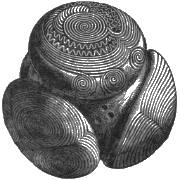Canmore Site 40010: FAIRY KNOWE, CRARAE - KILMICHAEL GLASSARY - BURIAL CAIRN (PREHISTORIC), CIST(S) (PREHISTORIC)(POSSIBLE), MIDDEN (PREHISTORIC), STANDING STONE (PREHISTORIC)(POSSIBLE)
Description
| Site Name | FAIRY KNOWE, CRARAE |
|---|---|
| Other Name(s) | CRARAE LODGE |
| Site Number | NR99NE 1 |
| Broad Class | MONUMENT (BY FORM), AGRICULTURE AND SUBSISTENCE, RELIGIOUS RITUAL AND FUNERARY, DOMESTIC |
| Site Type(s) | BURIAL CAIRN (PREHISTORIC), CIST(S) (PREHISTORIC)(POSSIBLE), MIDDEN (PREHISTORIC), STANDING STONE (PREHISTORIC)(POSSIBLE) |
| NGR | NR 9874 9736 |
| NGR accuracy | NGR given to the nearest 10m |
| Local Authority | ARGYLL AND BUTE |
| Parish | KILMICHAEL GLASSARY |
| Record created | 1988-04-18 |
| Last updated | 2010-07-22 |
Archaeology Notes
NR99NE 1 9874 9736
(NR 9874 9737) Stone Cist found (NAT)
OS 6" map (1900).
Only slight traces remain of Fairy Knowe, now merely a low mound.
Before 1865, at which time it was surmounted by a standing stone, a "stone coffin containing bones and ashes" was found. It was excavated in 1923, when the Knowe appeared as a circular mound, 108' in diameter, 5' - 6' high, covered by a layer of soil 6" - 1' thick. Four trenches were dug. Cairn material, of solidly packed earth and stones, was found in trench IV, most of trench III and the SW end of trench II, though it was absent elsewhere. In the middle of trench I, a small deposit of shells and blackened earth was found resting on the natural sand. A similar deposit was found in most of trench II. Among the shells were found pieces of bone and antler, from horse, cattle, sheep and deer.. In the centre of the mound, much of the stone mass was loose, without earth, and it was surmised that this was where the chamber had been. Not far from the centre was a stone slab, 4' x 2'6", lying on edge on top of the shell deposit. Similarly placed, there was another slab touching the N end of the first. Apart from these two slabs, nothing else was found to suggest the wall of a chamber or passage, nor were there any slabs suitable for roofing. No pottery, worked stones, nor bone, stone or bronze objects were found. Some of the shells and pieces of bone are in Fort William Museum (Acc No 249), described as coming from a chambered cairn, which the excavators believed it to be, no doubt influenced by the tradition that passages were found when the Knowe was first opened. If this opinion is correct then the Knowe, being round, would appear to have been some sort of Passage Grave. However, the almost total lack of structural evidence for either a chamber or a passage is to be noted. Moreover, the tradition mentioned two passages, probably in line, joined apparently by the central chamber. Such a structure is not to be expected in a Passage Grave. The round cairn and the probably central "stone coffin" would at first sight suggest a Bronze Age burial, but the passages, the standing stone, and the presence of horse bones among the animal bones found apparently undisturbed would argue against this. Examples of horse bones beneath Bronze Age round barrows are quoted (P Ashbee 1960), but such instances are rare, and to find both at one Bronze Age site would be highly unusual. The marine shells seem too widely spread to have been a funerary offering. Their presence may simply indicate that the Knowe was built on a far older refuse heap. It may be noted that a standing stone on a mound of sand marked the Viking burials of a man and woman at Ardvouray in Barra (NF60SE 14), and a standing stone also marked a Viking burial at Ballinaby, in Islay (NR26NW 4), but the evidence seems insufficient for definite conclusions to be drawn about the date of the Fairy Knowe.
Name Book 1865; J G Scott 1963; M Campbell and M Sandeman 1964.
In a small pasture field beside the drive to Crarae House is the grassed-over cairn measuring 25.0m in diameter and 1.2m high. The name "Fairy Knowe" is not known locally.
Surveyed at 1:2500.
Visited by OS (JP), 11 October 1971 .
Identifiers and Links to Other Records
This record has no links! Would you like to help?
| Identifier / External Link | Linked Record | Status | Comment |
|---|---|---|---|
| Canmore Site Number (legacy): NR99NE 1 | No linked record |
This area is visible only to logged in users.
